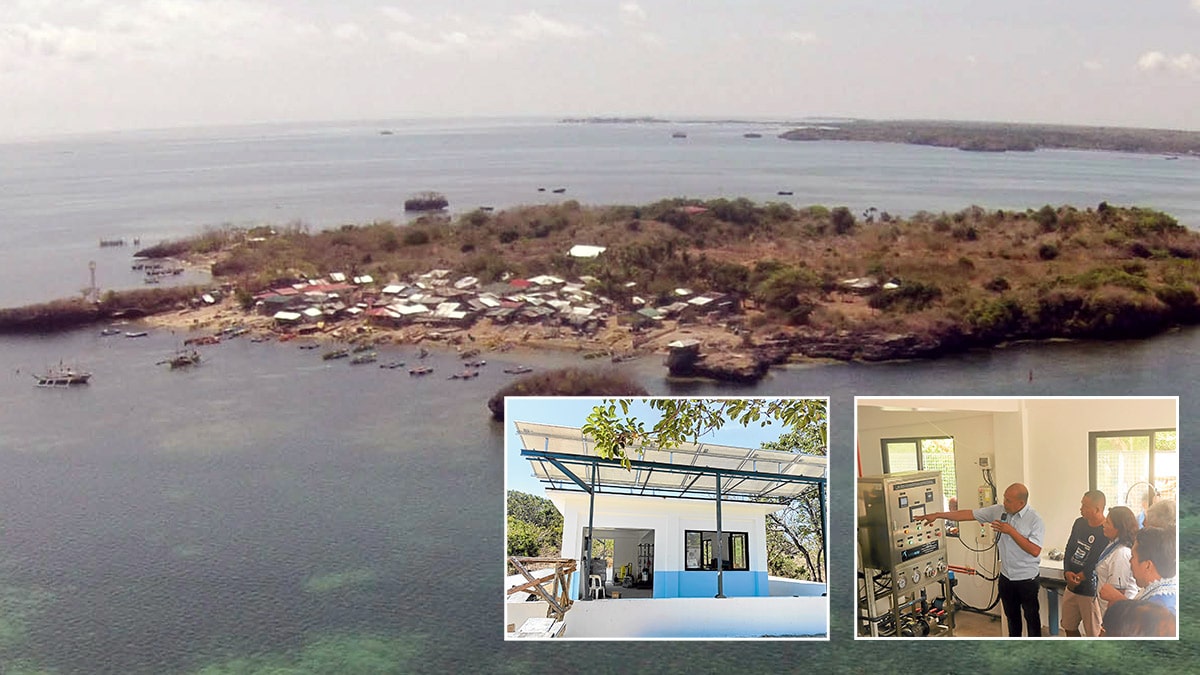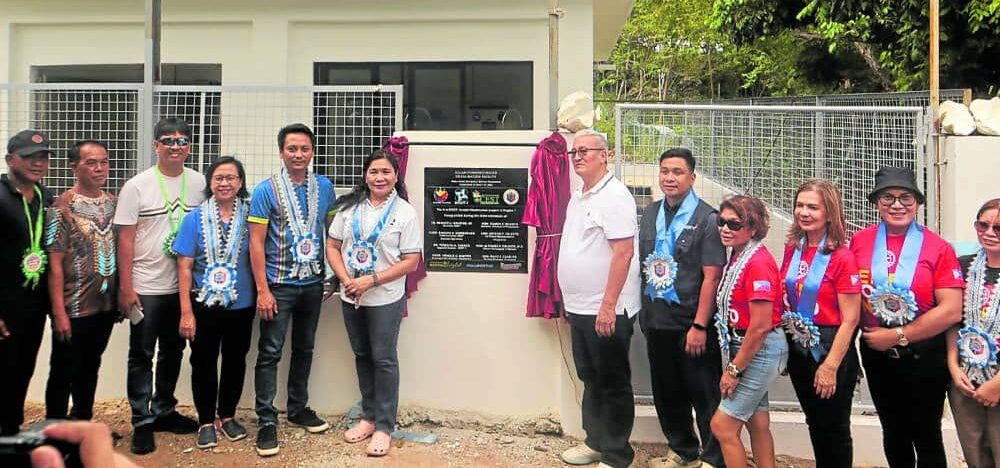
SEEING PROGRESS Fishing boats line one facet of Silaki Island, the place fishing serves as the first livelihood for residents. This heart-shaped group off mainland Bolinao in Pangasinan province is starting to beat its long-standing water shortage because the native authorities and the DOST within the Ilocos area labored collectively to construct a water desalination facility (inset, left). At proper, a technical officer from Summa Water, which was contracted by the DOST for the venture, explains how the ability works. —Photographs courtesy of Bolonao LGU and Dost
BOLINAO, PANGASINAN, Philippines — Residents of Silaki, a distant and picturesque island within the Lingayen Gulf, have lengthy confronted the problem of crossing the ocean to fetch water for his or her primary wants, together with for consuming, cooking and bathing.
That burden is now lifted with the set up of a P4.1-million solar-powered desalination facility, which converts seawater into potable water. This progressive resolution offers islanders with much-needed comfort, bringing a sustainable supply of recent water on to their group and bettering the standard of life on the island.
The venture, the primary of its sort within the Ilocos area, is a collaboration between the Division of Science and Expertise (DOST), which supplied the P2.8-million therapy facility, and the native authorities, which donated the land and constructed the P1.43-million constructing.
Silaki Island, a heart-shaped sitio (subvillage) of Barangay Binabalian on Santiago Island, is a part of Bolinao city. It covers solely 10 hectares and is residence to 89 households (about 380 residents) who depend on fishing and seaweed gathering for his or her livelihood.
Regardless of its idyllic setting, the island has lengthy confronted a major problem: the dearth of freshwater sources.
Article continues after this commercial
“The islanders should journey to both Santiago Island or mainland Bolinao to satisfy their water wants,” Bolinao Mayor Alfonso Celeste advised the Inquirer.
Article continues after this commercial
Positioned 11.5 kilometers from the mainland, Silaki is a 40-minute boat journey away, or 15 to twenty minutes by boat to Santiago Island.
Whereas residents don’t pay for water sourced from the mainland or Santiago, they nonetheless incur bills for boat gas, which prices about P300 per journey, mentioned municipal engineer Olanroy Celzo. Every journey can transport two 400-liter drums of water for home use, together with 20-liter containers of potable water, that are bought for P20 every.
“Every resident fetches their very own water,” Celzo mentioned.
The set up of the desalination facility has vastly improved the scenario. The plant, with a capability of 5,000 liters per day, will present recent water for island residents.
Whereas the plant desalinates sea water, it attracts from a deep nicely relatively than immediately from the Lingayen Gulf, decreasing the filtering course of.
Conserving rainwater
Initially, water can be supplied totally free, however the native authorities plans to impose a small price to cowl upkeep prices.
The brand new water supply is a welcome reduction for residents like Haydee Revilla, a 42-year-old mom of three and who serves as sitio chief.
Earlier than the institution of the ability, they collected rainwater every time potential and conserved each drop. Some residents had dug open wells, however the water was too salty for consuming, appropriate just for watering crops and different family duties.
“With water now obtainable on the island, we not should spend money and time fetching it from distant locations. The financial savings can go to different family necessities and to our kids’s college wants,” Revilla mentioned.
Enhancements
Past the water venture, Silaki Island has been seeing different enhancements.
In 2022, a faculty constructing was constructed, permitting kids from kindergarten to Grade 6 to attend college on the island. Beforehand, college students needed to cross the ocean to attend college on Santiago Island, a journey that was notably harmful in the course of the wet season. One other college constructing was donated by the Rotary Membership of Bolinao the next 12 months.
“Our kids not should threat their lives and limbs to go to highschool particularly throughout wet season,” Rivera mentioned.
Celeste mentioned the native authorities had been planning to develop the island, “however there are difficulties due to the space. Slowly, we’re in a position to put developments there.”


INAUGURATION Authorities officers led by Bolinao Mayor Alfonso Celeste (sixth from proper) and DOST Ilocos Director Teresita Tabaog (sixth from left) unveil the marker for the newly put in water desalination facility on Silaki Island, Bolinao, on Oct. 22. —Picture courtesy of Bolinao LGU
In 2016, TeaM Power, the operator of the 1,200-megawatt coal-fired energy plant in Sual city, supplied island residents with photo voltaic residence programs, together with photo voltaic panels and LED lights. Two years later, the corporate additional supported the group by putting in a 6.4-kilowatt photo voltaic battery charging station, enabling residents to energy small home equipment of their properties.
Silaki Island can also be recognized for being the positioning of a large clam farm, established within the Nineties by the College of the Philippines Marine Science Institute (UPMSI).
Protecting 16 ha of sea house, the farm serves as a nursery for big clams, regionally often called “taklobo,” serving to to revive the inhabitants of those once-endangered bivalves.
The farm has since turn out to be a vacationer attraction, drawing guests fascinated by the clams, whose shells can span as much as a meter extensive.
Vacationer vacation spot
Seeking to the long run, Celeste envisions Silaki Island turning into a key vacationer vacation spot, with its pristine seashores, recent marine merchandise and pleasant residents.
The native authorities, in partnership with UPMSI, is planning a community-based tourism venture, “The Legacy of the Sea: A Silaki Island Neighborhood-Primarily based Tourism Undertaking,” which gained P15 million in funding as a part of the Tourism Champion Problem of the Division of Tourism. A P12-million counterpart fund has been put aside by the Bolinao authorities.
Earlier than tourism totally takes off, nevertheless, residents are already reaping the advantages of important social companies lastly reaching their distant island.


